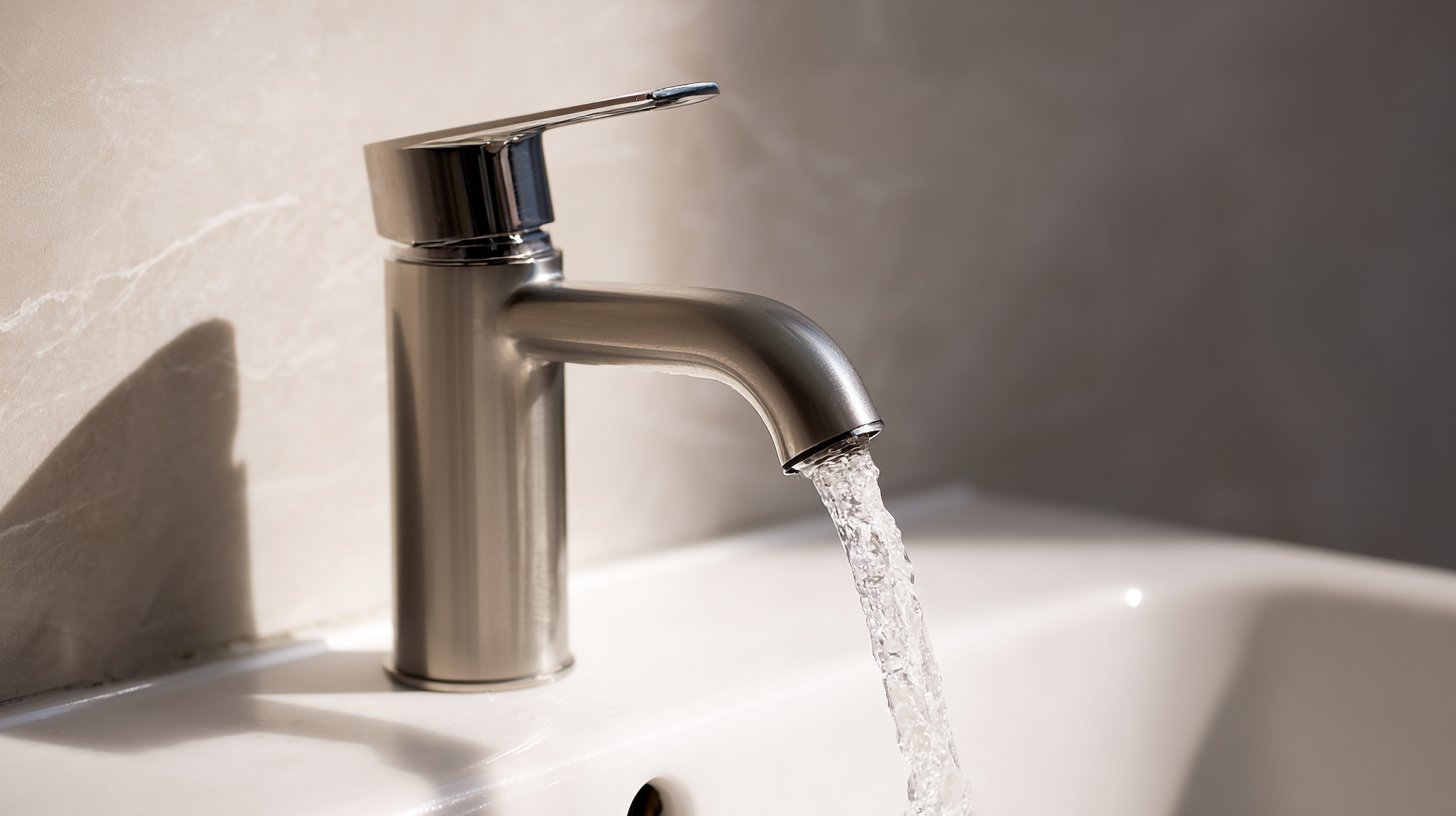- Home Page
- Company Profile
-
Our Products
- Coral Collection Volga
- Continental Collection Riva
- Pearl Collection Volga
- Moon Collection Volga
- Allied Collection Volga
- Onyx Collection Riva
- Lotus Collection Riva
- Rose Collection Riva
- Prince Collection Volga
- Fusion Collection Volga
- Desire Collection Riva
- Opal Collection Volga
- Sapphire Collection Volga
- Flora Collection Riva
- Sensors Collection Volga
- Royal Collection Volga
- Sumo Collection Volga
- Flora Collection Bathroom Accessories
- Versa Collection Volga
- Bathroom Fittings & Accessories
- Cubix Collection Riva
- Squaro Collection Volga
- Choras Collection Volga
- Taj Collection Volga
- Arya Collection Volga
- Blog

The Future of Innovations in Faucet Manufacturing
In recent years, the faucet manufacturing industry has been undergoing a remarkable transformation driven by technological advancements and evolving consumer preferences. According to a report by Grand View Research, the global faucet market is projected to reach USD 27.96 billion by 2025, growing at a CAGR of 5.9% during the forecast period. This growth signifies the increasing demand for innovative designs and eco-friendly solutions among consumers worldwide.

As a result, faucet manufacturers are not just focusing on aesthetics but are also integrating smart technologies, like touchless operations and water-saving features, to enhance user experience and meet sustainability goals. This blog will explore the future of innovations in faucet manufacturing, providing a comprehensive checklist for industry stakeholders to stay ahead in this competitive landscape.
Emerging Technologies Revolutionizing Faucet Production
The faucet manufacturing industry is on the brink of transformation, thanks to emerging technologies that are revolutionizing production processes. According to a 2023 report by Global Industry Analysts, the faucet market is expected to grow by approximately 7% by 2028, driven by advancements in smart technology and eco-friendly materials. Manufacturing methods such as 3D printing are enabling companies to create complex designs with reduced waste and shorter lead times. This not only enhances customization but also aligns with sustainability goals, reducing the carbon footprint associated with traditional manufacturing.
One significant innovation involves the integration of IoT (Internet of Things) technology into faucets. Smart faucets equipped with sensors and connectivity features allow users to control water usage more efficiently, providing real-time data on consumption. Industry experts predict that smart faucets will capture over 20% of the market share by 2026. As a tip for manufacturers looking to stay competitive, investing in renewable materials and adopting smart technology will be crucial in meeting consumer demand and driving innovation.
Furthermore, automation in factory settings is streamlining production processes, resulting in higher efficiency and lower operational costs. A report by Research and Markets indicates that automation can reduce production time by up to 30%. For companies, this shift allows for quicker turnaround times and the ability to respond swiftly to market changes. Manufacturers should consider adopting robotic solutions to enhance precision and reduce labor-intensive tasks, positioning themselves for future success in an increasingly competitive landscape.
Sustainable Materials and Their Impact on Faucet Design
As the demand for sustainable products rises, faucet manufacturers are increasingly turning to eco-friendly materials to reshape their designs. The shift towards sustainable materials, such as recycled metals, biodegradable plastics, and bamboo composites, not only reduces environmental impact but also opens new avenues for creativity in design. By integrating these materials, designers can create faucets that are not only functional but also aesthetically pleasing and in harmony with modern sustainable living spaces.
The use of sustainable materials in faucet design also influences the manufacturing process. Innovative techniques, such as 3D printing and advanced machining, allow for more efficient use of resources, minimizing waste. Furthermore, these approaches often lead to lighter, more durable products, increasing the lifespan of faucets while ensuring they meet rigorous performance standards. As consumers become more environmentally conscious, the combination of style and sustainability in faucet design will undoubtedly play a crucial role in shaping the future of innovations in faucet manufacturing.
The Future of Innovations in Faucet Manufacturing
Smart Faucets: Integrating Technology for Enhanced User Experience
The advent of smart technology has revolutionized countless industries, and faucet manufacturing is no exception. With the rise of smart faucets, homeowners can look forward to a seamless integration of convenience and efficiency in their daily routines. These faucets come equipped with touchless sensors, temperature controls, and even voice activation, allowing users to adjust water flow and temperature without the need for physical contact, promoting hygiene and ease of use.
When selecting a smart faucet, consider the compatibility with your existing plumbing and any smart home ecosystems you may already have in place. Look for models that offer app integration, enabling you to control your faucet remotely and monitor water usage—a handy feature for those aiming to conserve water. Additionally, be sure to read reviews and check the warranty, as the technology in smart faucets can vary significantly in quality and reliability.
To enhance your experience further, maintain your smart faucet by regularly checking for software updates and cleaning any sensors or touch surfaces. Regular maintenance not only extends the lifespan of the faucet but also ensures it operates efficiently, providing you with the best possible user experience in your kitchen or bathroom. Embracing these innovations means enjoying the perfect blend of technology and practicality in your home.

Innovative Manufacturing Techniques Improving Efficiency
In recent years, innovations in faucet manufacturing have seen significant advancements, driven largely by new manufacturing techniques that enhance efficiency and reduce waste. According to a market research report by Grand View Research, the global faucet market is projected to reach USD 17.6 billion by 2027, growing at a CAGR of 5.4%. This growth is largely attributed to technological developments in production processes, such as the adoption of automation and 3D printing. These techniques allow manufacturers to streamline operations, minimize material costs, and create more intricate designs without compromising quality.

Additionally, the integration of smart technologies into manufacturing processes has further propelled efficiency. The use of Internet of Things (IoT) devices enables real-time monitoring of production lines, reducing downtime and improving output. A report from the International Journal of Advanced Manufacturing Technology highlights that companies implementing IoT solutions in their workflow have reported up to a 30% increase in production efficiency. This shift towards innovative manufacturing not only addresses consumer demand for sustainable, high-quality faucets but also positions companies to thrive in an increasingly competitive market.
Trends Shaping the Future of Faucet Aesthetics and Functionality
The faucet manufacturing industry is witnessing a significant transformation driven by emerging trends in both aesthetics and functionality. According to a recent report by Allied Market Research, the global faucet market is projected to reach $25.1 billion by 2025, growing at a compound annual growth rate (CAGR) of 6.2%. This growth is largely influenced by the increasing consumer demand for innovative designs that not only elevate the interior decor but also enhance user experience. Manufacturers are focusing on creating faucets that integrate seamlessly with modern kitchens and bathrooms, utilizing materials such as brushed nickel and matte black finishes that are gaining popularity among consumers.
In addition to aesthetics, technological advancements are reshaping the functionality of faucets. The rise of smart home technology has paved the way for touchless faucets and voice-activated controls. A report from the National Kitchen & Bath Association indicates that 40% of homeowners are now considering smart features when renovating their spaces. This trend highlights the growing awareness of hygiene and water conservation amongst consumers. By incorporating features like automatic shut-off and built-in filtration systems, manufacturers are not only appealing to environmentally conscious buyers but also aligning with the evolving standards of contemporary living. As these trends continue to intersect, the future of faucet manufacturing promises to be both innovative and sustainable.
The Future of Innovations in Faucet Manufacturing - Trends Shaping the Future of Faucet Aesthetics and Functionality
| Trend | Description | Impact on Aesthetics | Impact on Functionality | Sustainability Features |
|---|---|---|---|---|
| Smart Technology | Integration of sensors and connectivity for customized user experiences. | Sleek designs with minimalistic controls. | Enhanced user control and convenience. | Energy-saving features that reduce water consumption. |
| Eco-Friendly Materials | Use of recycled and sustainable materials in faucet construction. | Natural textures and finishes that appeal to eco-conscious consumers. | Increased durability and lifespan of the products. | Support for green building certifications. |
| Modular Designs | Faucets that can be customized or upgraded with different components. | Versatile styles that match varied interior aesthetics. | Improves functionality through adaptability. | Promotes waste reduction by allowing upgrades instead of replacements. |
| Aesthetic Innovation | Focus on artistic elements and design themes such as industrial, vintage, and seamless integrations. | Unique forms and finishes that enhance the overall space. | Enhances user experience through beautiful design. | Incorporates elements that reduce maintenance and extend product life. |
Developed and Managed by Infocom Network Private Limited.


